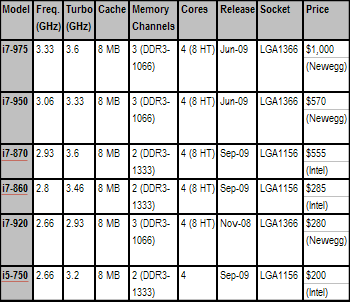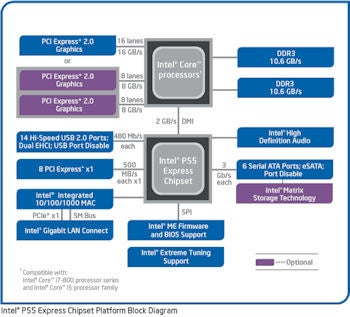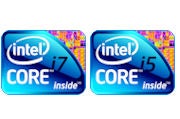Editor's Note:This story covers the Intel Core i5 and i7 processors that were introduced in September, 2009. To learn about the more recent "Sandy Bridge" versions of these processors, see Intel's Sandy Bridge CPUs: What to Expect . And check out our exclusive lab testing to see how Sandy Bridge stacks up against previous processors.
Intel's full processor breakdown--including the axing of its Core i7 940
processor--includes some potentially confusing differences between the chips. So here's what you need to know.
The existing Core i7 900-series processor lineup, codenamed Bloomfield, now features three separate products: 3.33-GHz Core i7 975, 3.06-GHz Core i7 950, and 2.66-GHz Core i7-920 processors. Between the Core i7-950 and Core i7-920 processors sit the new "Lynnfield" 2.93-GHz Core i7 870 and 2.8-GHz Core i7 860 processors. The brand-new, 2.66-GHz Core i5 750 CPU is a Lynnfield chip as well, but we'll get to that odd duckling further below.

That part still rings true for the new Core i7 800-series and Core i5 CPUs--all three run on Intel's latest P55 chipset and LGA1156 socket, which necessitates a new motherboard purchase for use. What's changed, however, is that the Core i7 800-series and Core i5 CPUs each adopt different permutations of the fanciest of the Core i7 900-series' features.
All three chips have dropped down from a QuickPath Interconnect and triple-channel memory controller to a Direct Media Interface and dual-channel memory controller. But don't freak out; This is more a loss of future-proofing than anything else given the minute performance differences between current dual- and triple-channel memory configurations.
An integrated PCI Express graphics controller on the Lynnfield CPUs can either deliver 16 lanes of bandwidth to a single PCI Express 2.0 videocard or split this connection into two x8 lanes for an SLI or CrossFire setup. Although it's a cut from the full 32 lanes (for a dual 16x or quad-8x configuration) provided by Core i7's X58 chipset, the bandwidth reduction should only affect those crazy enough to SLI or CrossFire dual-GPU videocards on a Lynnfield setup.

The new Core i7 800-series CPUs and the Core i5 750 still support the same automatic overclocking functionality, or Turbo Boost, as the Core i7 900-series processors. However, this feature has been jacked up on the newer chips. Core i7 900-series CPUs will only increase their multipliers to a maximum of two additional steps according to system demands (effectively taking a 3.33-GHz processor to 3.6-GHz depending on how many cores are in use). The new Lynnfield processors are able to jump up five multiplier steps for the 800-series chips (taking a 2.93-GHz processor to 3.6-GHz) and four for the Core i5 750 (2.66-GHz to a maximum 3.2-GHz).
Test Bed: Intel DP55KG Motherboard, 4GB DDR3 1333 RAM, ATI Radeon HD 4890 graphics, 2x Seagate ST3750630AS hard disks (Raid 0), Windows Vista Ultimate 64 bit Service Pack 2
So where does that leave the Core i7 870? Given that its price is almost identical to that of the high-end 3.06-GHz Core i7 950 CPU, a processor that natively runs faster than the 2.93-GHz Core i7 870, it's difficult to see the compelling reason to pick up this chip. The Turbo Boost feature of the Core i7 870 does ultimately beat the speeds of the Core i7-950's, but for the enthusiast market, the increased memory support and bandwidth for multi-GPU setups might not be worth giving up. The Core i7 860 is more reasonably priced at $285, provided you can make sufficient use of its hyperthreading functionality.
It remains to be seen just how far the Core i7 800-series CPUs will overclock compared to the Core i7 900-series chips-the lower power draws of the 800-series processors could make quite a difference in this area. As for the Core i5 750, this chip looks to be a solid winner for those looking to dip their toes into the Nehalem platform without breaking the bank-given Intel's dramatic price points, that's always a strong possibility.

Intel's full processor breakdown--including the axing of its Core i7 940
processor--includes some potentially confusing differences between the chips. So here's what you need to know.
The existing Core i7 900-series processor lineup, codenamed Bloomfield, now features three separate products: 3.33-GHz Core i7 975, 3.06-GHz Core i7 950, and 2.66-GHz Core i7-920 processors. Between the Core i7-950 and Core i7-920 processors sit the new "Lynnfield" 2.93-GHz Core i7 870 and 2.8-GHz Core i7 860 processors. The brand-new, 2.66-GHz Core i5 750 CPU is a Lynnfield chip as well, but we'll get to that odd duckling further below.

Technology Differences
Intel took a big leap forward in the design department when it launched Core i7 900-series processors last November. Just a few of these included a new triple-channel memory controller integrated into the chip, a new QuickPath Interconnect system to replace (and improve upon) the front-side bus architecture of old, and the return of hyperthreading that split the chip's four physical cores into eight virtual cores for increased system performance. As the Core i7 900-series chips were based on a new Intel X58 chipset and LGA1366 socket, aspiring upgraders had to invest in new motherboards to reap the benefits of the Core i7 900-series platform.That part still rings true for the new Core i7 800-series and Core i5 CPUs--all three run on Intel's latest P55 chipset and LGA1156 socket, which necessitates a new motherboard purchase for use. What's changed, however, is that the Core i7 800-series and Core i5 CPUs each adopt different permutations of the fanciest of the Core i7 900-series' features.
All three chips have dropped down from a QuickPath Interconnect and triple-channel memory controller to a Direct Media Interface and dual-channel memory controller. But don't freak out; This is more a loss of future-proofing than anything else given the minute performance differences between current dual- and triple-channel memory configurations.
An integrated PCI Express graphics controller on the Lynnfield CPUs can either deliver 16 lanes of bandwidth to a single PCI Express 2.0 videocard or split this connection into two x8 lanes for an SLI or CrossFire setup. Although it's a cut from the full 32 lanes (for a dual 16x or quad-8x configuration) provided by Core i7's X58 chipset, the bandwidth reduction should only affect those crazy enough to SLI or CrossFire dual-GPU videocards on a Lynnfield setup.
Turbo Boost: Automatic Overclocking

The new Core i7 800-series CPUs and the Core i5 750 still support the same automatic overclocking functionality, or Turbo Boost, as the Core i7 900-series processors. However, this feature has been jacked up on the newer chips. Core i7 900-series CPUs will only increase their multipliers to a maximum of two additional steps according to system demands (effectively taking a 3.33-GHz processor to 3.6-GHz depending on how many cores are in use). The new Lynnfield processors are able to jump up five multiplier steps for the 800-series chips (taking a 2.93-GHz processor to 3.6-GHz) and four for the Core i5 750 (2.66-GHz to a maximum 3.2-GHz).
Performance
Both Core i7 800-series processors support hyperthreading the same as their Core i7 900-series brethren. The Core i5 750 does not-its four physical cores are all that will appear in your operating system's task manager. Even so, the CPU's noteworthy performance makes it an excellent value for its roughly $200 price. We only saw a performance difference of 5 percent between the Core i5 750 and the roughly $555 Core i7 870 (based on WorldBench 6 testing of the two CPUs on identical system builds). In fact, the Core i5 750's score of 127 falls right around the scores set by competing Value and Power PCs that use Core i7 920 processors.Test Bed: Intel DP55KG Motherboard, 4GB DDR3 1333 RAM, ATI Radeon HD 4890 graphics, 2x Seagate ST3750630AS hard disks (Raid 0), Windows Vista Ultimate 64 bit Service Pack 2
So where does that leave the Core i7 870? Given that its price is almost identical to that of the high-end 3.06-GHz Core i7 950 CPU, a processor that natively runs faster than the 2.93-GHz Core i7 870, it's difficult to see the compelling reason to pick up this chip. The Turbo Boost feature of the Core i7 870 does ultimately beat the speeds of the Core i7-950's, but for the enthusiast market, the increased memory support and bandwidth for multi-GPU setups might not be worth giving up. The Core i7 860 is more reasonably priced at $285, provided you can make sufficient use of its hyperthreading functionality.
It remains to be seen just how far the Core i7 800-series CPUs will overclock compared to the Core i7 900-series chips-the lower power draws of the 800-series processors could make quite a difference in this area. As for the Core i5 750, this chip looks to be a solid winner for those looking to dip their toes into the Nehalem platform without breaking the bank-given Intel's dramatic price points, that's always a strong possibility.







0 comments:
Post a Comment